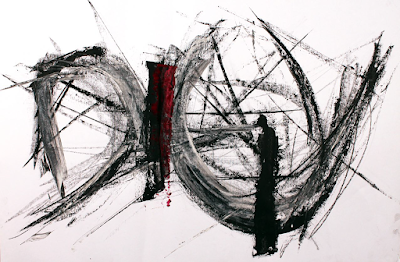Hestia gallery, situated in the center of the old part of Belgrade, is the contemporary art gallery that also functions as a residency space for artists. The exhibition Fragments I, curated by independent curator Maja Ciric was opened in Hestia gallery on the 15th of December (and will be open till 24th of February) presents a six-channel video installation by Vangjush Vellahu.
Vellahu is born in Pogradec in Albania, and today he lives and works in Berlin. Since 2014 he is part of a local group of emerging young artists – Nucleu 0000 in Bucharest, Romania, that tries to coagulate an arts organization as a response to the lack of cultural finance. He creates artistic videos, objects or some kind of archives that focus on different social issues and experience of specific communities. Usually, most of his artworks have the form of storytelling, with the narrative constructed and told by individuals from certain communities with the interesting and problematic political and socio-economical background. The focus of his artworks is an exploration of the collective memory of authoritarian regimes or personal experience of living in hard conditions in conflict and post-conflict zones. The artworks of Vellahu intertwine urban histories of entities that from an ideological and political standpoint remain on the margins of recognition. In his travels, the artist takes visual notes, making a journal-like works, with the great desire to document the influence of politics on the realities of local communities. Videos are reconfigurations that attempt at re-defining the popular understanding of what borders, territories or geographies represent today. His research is influenced by subjects coming from his personal past shaping the way in which he relates to recent histories.
In those artworks presented at Hestia the artist documents the present situation of six unrecognised republics, giving a more personal testimony to the multi-layered histories of these forgotten entities. It is a complex topic involving international actors whose active/passive, from the top down approach, determines how these entities continue to coexist. About this project Vellahu says:
I collect people’s stories whose collective drama is not only a trace left on their experiences of war, but also the kind that remains embedded in buildings and landscapes that continue to bear witness to what’s left of the past. Through a further exploration of the subject, I look at how memories effect the understanding and reflection on what had happened, shaping the way in which people identify with their everyday realities, that are often frozen and in conflict. The list of unrecognised states with a de facto control over their territory is long. This work is a prologue that needs to continue.
Vangjush Vellahu’s journey takes place through the ruined urban and rural landscapes of semi- or non-recognized post-Soviet (the Pridnestrovian Moldavian Republic, the Republic of South Ossetia, the Republic of Abhkazia, and the The Nagorno-Karabakh Republic), post-Yugoslav (the Republic of Kosovo) and post-colonial (the Turkish Republic of Northern Cyprus) states during the period between 2015 and 2017. Watching these videos one is put in the position of a visitor of these semi-recognize or not recognized countries, travelling along the artist and witnessing the stories of people who come from or live in these countries. Most of the videos don’t directly show people and their lives, in fact, there are barely any representations of everyday life and depictions of individuals, the videos are rather displaying the post-conflict scenarios, usually landscapes with architecture. Those scenarios sometimes, like in a video illustrating the region of Abhazia, can seem postapocalyptic - no people, destroyed architecture, nature taking over the ruins, and all that accompained with the narrator’s voice. It is clear that the biggest victim of conflicts and imperialist fights for power and control over the region, is the local community, meaning not only people but also polluted nature and ruined architecture. The visual effect of this postapocalypse is particularly clear when empty streets are contrasted with huge socialist architecture, also usually abandoned.
The curator, Maja Ciric says:
This is not exhibition about borders. Rather, it is an exhibition about overcoming the influence of politics on the land withing the borders of unrecognized or semi-recogized states… Borders are much more than a pure division of geographical or legal entities; they are also mental, conceptual borders, ones situated between separated worlds that do not operate together in the same timeframe, one being a matter of the past, the other a matter of future… By connecting all that he encounters on this journey, Vellahu bridges between distant countries bound together by a common status, or, more importantly, bound by the effect of that status, and the visual and the conceptual consequences that are ruled by it.
The the artistic side of this politically engaged documentary videos is primarily in the ability of the artist to bring together ethics and aesthetics without loosing the sensitivity for local specificities both contextually and visually. He doesn’t pick sides or agitates for clear political position, but rather plays the role of the curious researcher, observer of other people’s destinies and narratives. In this way, his art escapes being a propaganda and functions as mimesis, like artist’s frames become Alberti’s window. The project is not over, it has a concept of evolving artwork and in that sense this exhibition Fragments I is a prologue to further investigation and artistic documentation of these socio-politically turbulent areas.














Comments0
Post a Comment